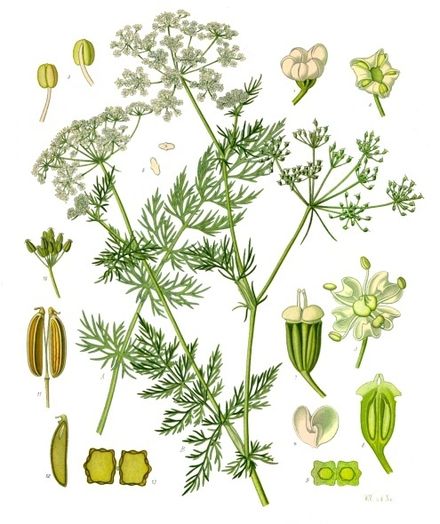Caraway (Carum carvi), also known as meridian fennel,or Persian cumin,is a biennial plant in the family Apiaceae,native to western Asia,Europe and Northern Africa.

The plant is similar in appearance to other members of the carrot family, with finely divided, feathery leaves with thread-like divisions, growing on 20–30 cm stems. The main flower stem is 40–60 cm tall, with small white or pink flowers in umbels. Caraway fruits (erroneously called seeds) arecrescent-shaped achenes, around 2 mm long, with five pale ridges.
Caraway has been used as a medicine and a flavoring since the early Egyptians. Its cultivation is mentioned in the Bible and archeological sites dating back 5000 years have been found to contain caraway seeds in food remains. Caraway is a very attractive plant with its feathery foliage and caraway fragrance and flavor throughout. Flowers in umbrella shaped clusters of white or pink produce seeds the second year to use in sauerkraut, rye bread, cheeses, vegetables and soups. Leaves are tasty in soups, salads and veggies.
Family:
Apiaceae
Genus:
Carum
Species:
C. carvi
In the traditional Europian cuisine, caraway seed is one of the dominant spice featuring in several savory dishes.
Strongly aromatic, caraway is a member of parsley or Umbelliferae family; a large
family of herbs that also includes commonly known herbs and spices such as dill,
anise,
fennel,
cumin, etc.
Caraway is grown extensively all over Europe, North Africa, and Asia Minor regions. This biennial, herbaceous plant blooms creamy flowers in umbels once in every two years. It grows to about 2 feet in height and bears small feathery leaves. Caraway seeds, having similar in appearance as that of
cumin, are crescent in shape, dark brown, with up to five stripes (ribs) running lengthwise.
Caraway generally harvested during early hours of the day to avoid spilling of its seeds on the ground. They are then staked in bundles and allowed to dry under sunlight, and their seeds then threshed, either mannually or using machines.
Caraway water is sometimes used in treating flatulence and indigestion in traditional medicines, especially used to relive infantile colic.
It is also used in pharmaceuticals as flavoring agent in mouthwash and gargle preparations.
Caraway extraction is used as a rubefacient (to soothe muscle sores), clear the cold, as a remedy in bronchitis and irritable bowel syndrome in many traditional medicines. (Medical disclaimer).
Caraway seeds have a warm, sweet, and slightly peppery aroma when squeezed between index and thumb fingers. Its seeds are used extensively in European and Mediterranean cooking.
In order to keep fragrance and flavor intact, caraway seeds are generally roasted gently under light heat and ground just before using them in a recipe.
Amazon : $3.5 250s
mvseeds :
$20.40 lb
neseed :
34.95 lb
| Seeds per oz |
11,000 s/oz |
|
|
|
| Best Buy |
mvseeds
neseed |
$ per M |
$ per lb |
Rating |
| Amazon |
$3.5 250s |
14.00 |
|
|
| mvseeds |
lb $20.40 |
|
|
** |
| neseed |
34.95 lb |
|
|
* |
| hazzards
greenhouse |
$10.08 10M |
1.00 |
|
|
| SeedsNOW |
$3.99 2M |
|
|
|





















